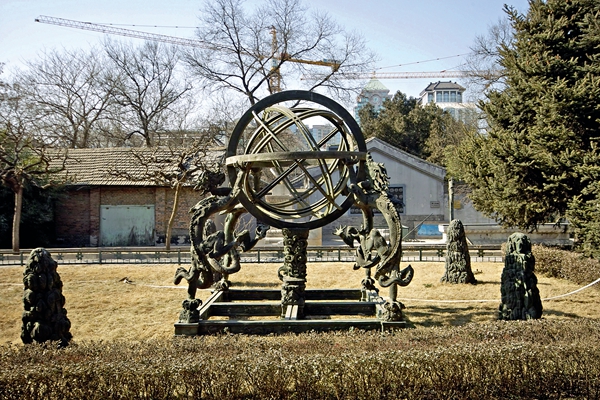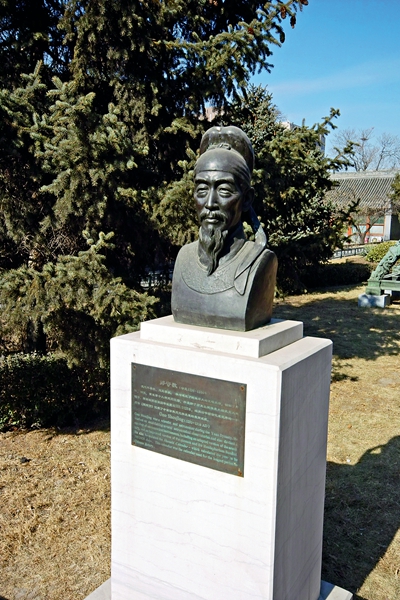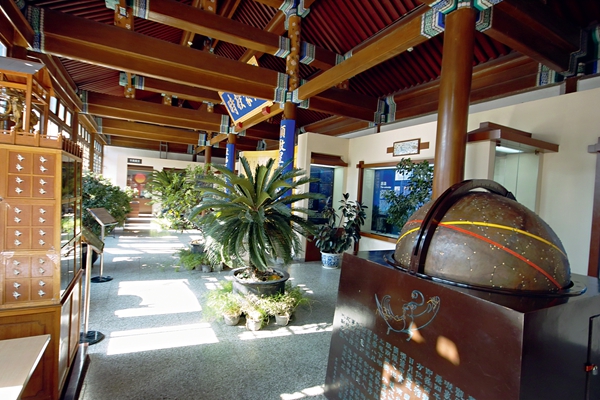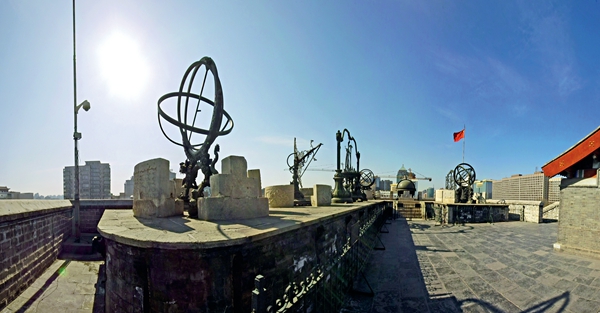By BRIAN SALTER
By BRIAN SALTER
THE walls at Jianguomen Station give you a hefty clue of what attractions are in the area before you’ve even exited the train. In common with many other subway stations in Beijing, you can get a pretty good idea of what famous monuments are close by, simply by looking at the tiles or mosaics that decorate the platforms.
A passer-by might be surprised to see an ancient observatory situated on the top of a fort-like building at Jianguo Gate, with some archaic instruments clearly visible on the skyline; but the Beijing Ancient Observatory is a pre-telescopic observatory located just around the corner from Exit C of the station.

In 1421 the Ming Dynasty (1368-1644) moved its capital to Beijing and the observatory was built along the city wall the following year. As the Emperor was regarded as the Son of Heaven, the movements of the heavenly bodies were highly significant, so the observatory was built to serve the Ming and Qing (1644-1911) astronomers in their star-gazing reports that they prepared for the Emperor.
Another of its functions was to assist with sea navigation, and to this end, Muslim scholars were recruited for their expertise. However, in the mid-17th century, after winning an astronomy contest, the Jesuit Ferdinand Verbiest (1623-1688) was awarded complete charge of the observatory by the emperor. In 1673, he supervised the rebuilding of some of the instruments; and he and other Jesuits helped to further develop the observations of the stars and planets.

Actually, the original name of this place was the Administration of Heaven Observatory. It was changed to Constellation Observatory (or literally “Platform of Star Watching”) in 1442 by Emperor Yingzong of the Ming Dynasty and known simply as the Observatory in the Qing Dynasty. The name was further changed to “Central Observatory” after the Revolution of 1911.
The Jianguomen observatory is the only surviving example among the several observatories constructed during the Jin (1115-1234), Yuan (1279-1368), Ming, and Qing dynasties. The observatory itself is located on a 15 meter high brick platform of about 40x40 square meters, which is one of the few surviving portions of the old Ming-era city wall that once encircled Beijing. Eight huge, but ornately carved, bronze astronomical instruments can be found on this platform, while others are located at ground level. All have been well preserved since the time of the Qing Dynasty. You can clearly see the confluence of cultures of oriental craftsmanship and European Renaissance in the design of these instruments, which include a celestial globe, a dragon quadrant, an ecliptical armillary sphere, and an azimuth theodolite.

The Quadrant, built in 1673, was used to measure the altitudes and zenith of celestial bodies, while the Armillary Sphere was an instrument used to measure the coordinates of celestial bodies. It is constructed of two bronze disks – one known as an ecliptic armillary (for tracking the sun), and the other the equatorial armillary (which tracks other bodies that are not the Sun). The theodolite, built in 1715, was used for measuring the azimuth coordinates of celestial bodies.
Luckily, for those who do not have a background in astronomy, there are plenty of notices in English explaining the history and use of these ancient objects. The museum curators have gone to a lot of trouble to make things crystal clear, not just for Chinese visitors, but also for foreign visitors.
As one of the oldest observatories in the world, the Beijing Ancient Observatory covers an area of 10,000 square meters. Below the stairway to the observation deck stand two magnificent Pixiu (a mythical creature) guarding a former entrance into the grounds. They stare out over an attractive garden to the rear, which has sundials, armillary spheres, and other contraptions which serve as purely decorative ornaments for the expansive lawn.

Two of China’s famous astronomers – Wang Xun (1235-1281) and Guo Shoujing (1231-1316) – have their busts proudly on display in the garden. Guo Shoujing worked on establishing several astronomical observatories and also devised a number of instruments including an adapted version of the armillary and an improved version of the gnomon and the hemispherium sundial. He also formulated the Shoushi Calendar which calculated the year to be exactly 365.2425 days!
One of the prettiest instruments on display is a sundial which is a copy made in 1955 of an original which you can see on the left side of the Taihe Hall (Hall of Supreme Harmony) in the Forbidden City. It mainly determines the local true solar time by the direction of the solar shadow. Four lost pillars were also installed when it was renovated in 1991 in order to restore it to its original appearance.
There’s also a rather splendid gnomon (γνμων is an ancient Greek word meaning “indicator”; hence a gnomon is that part of a sundial that casts the shadow) which is a 1983 copy of one made by Guo Shoujing that was previously mentioned. By measuring the length of the solar shadow projected on the gnomon at high noon, using pin hole imaging, it determined the winter and summer solstice and the length of a tropical year.
Actually, the Chinese were highly advanced in astronomy. From the Xia Dynasty (c.2070-c.1600 BC) to the end of the Qing Dynasty, more than 4,000 observations of comets were made, 90 novas and supernovas were spotted, more than 200 sunspots, and more than 1,000 solar eclipses observed.
Inside one of the galleries, you can learn about some of the darker history of the Observatory, such as the looting by the eight-power allied forces in 1900. The French took five instruments – the Abridged Armilla, Equatorial Armilla, Ecliptic Armilla, Azimuth Theodolite, and Quadrant – and hauled them back to their embassy; but they finally returned them all in 1902.
The Germans, who took an Armillary sphere, celestial globe, New Armilla, Altazimuth, and sextant back to their country and put them on display in Potsdam Hall, finally returned them to China after World War I in 1921.
In 1931, some of the more ancient instruments were sent to Nanjing, capital of Jiangsu Province, to evade the invading Japanese army, which is why Beijing now has copies rather than the originals. Those in Nanjing can be found at the Purple Mountain Observatory Museum and the Nanjing Museum.
BRIAN SALTER is a broadcaster and journalist who has been working in China for the past five years.